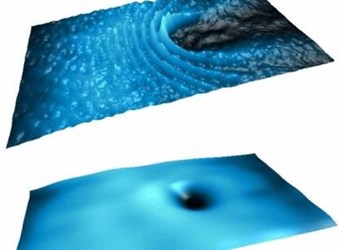A Stream Of Superfluid Light

The work of Professor Stéphane Kéna-Cohen of Polytechnique Montréal demonstrated the ability of light to flow without friction when meeting an object under special conditions.
For centuries scientists have known that light has wave behavior. However, the fact that light can also behave like a liquid by creating vortices and undulations when it encounters an object, such as water flowing in a river, is a much more recent discovery, Active search. The "liquid" properties of light manifest themselves under special conditions, when the photons composing the light wave can interact with one another.
Researchers at the CNR NANOTEC in Lecce, Italy, in collaboration with Polytechnique Montréal, have shown that for a light flow "dressed" by electrons, an even more dramatic effect occurs. The light becomes superfluid, it flows without friction at the meeting of an object and continues its journey behind it without the slightest turbulence.
Daniele Sanvitto, who heads the research group at NANOTEC, says that "superfluidity is a remarkable effect normally observed only at temperatures close to absolute zero (-273 degrees Celsius), as in liquid helium or atomic gases ultracold. What is extraordinary in our work is that we have demonstrated that superfluidity can also occur at ambient temperature and under ambient conditions by using quasi-particles formed by the strong coupling between light and matter, polaritons. "
Sanvitto adds that "superfluidity, which allows a fluid in the absence of viscosity to rise along the walls of a container and to drain it, is associated with the ability of some particles to condense in A quantum state called Bose-Einstein condensate. In this state, the particles behave like a single macroscopic wave, all oscillating at the same frequency. A similar phenomenon occurs, for example, in superconductors: the electrons, in pairs, condense and create superfluids or supercurrents capable of conducting electricity without loss ".
These experiments have shown that it is possible to obtain superfluidity aat room temperature, whereas until now this property was only attainable at temperatures close to absolute zero. This could lead to its use in future photonic devices.
Stéphane Kéna-Cohen, assistant professor in the Department of Physical Engineering at Polytechnique Montréal and coordinator of the Montreal team, adds: "For this demonstration, we made an extremely thin film of organic molecules between two highly reflective mirrors. In such a structure, light interacts so strongly with molecules when it bounces between mirrors that this leads to the creation of quasi-light-matter particles, polaritons. These quasi-particles have several properties similar to photons, such as a low effective mass and a speed close to that of light, but they can also interact with one another thanks to the electrons inside the molecules. Under normal conditions, light should reflect and diffuse by encountering an obstacle. For a superfluid, Any diffusion or turbulence is suppressed and the light propagates without being disturbed. "
The research team states that "the fact that it is possible to observe such an effect under ambient conditions will generate a lot of future work, not only to study the physics of Bose-Einstein condensates in But also to design future photonic devices using superfluids in which the losses by diffusion would be completely eliminated and new unexpected phenomena could be exploited ".
These experiments will be published today in the issue of Nature Physics of June 5, 2017 and are the culmination of work carried out at the Advanced Photonics Laboratories of the Institute of Nanotechnology of the Italian National Research Council in Lecce in collaboration with Polytechnique Montréal, The Center of Excellence of Aalto University in Finland and Imperial College London.
Source: Polytechnique Montreal
